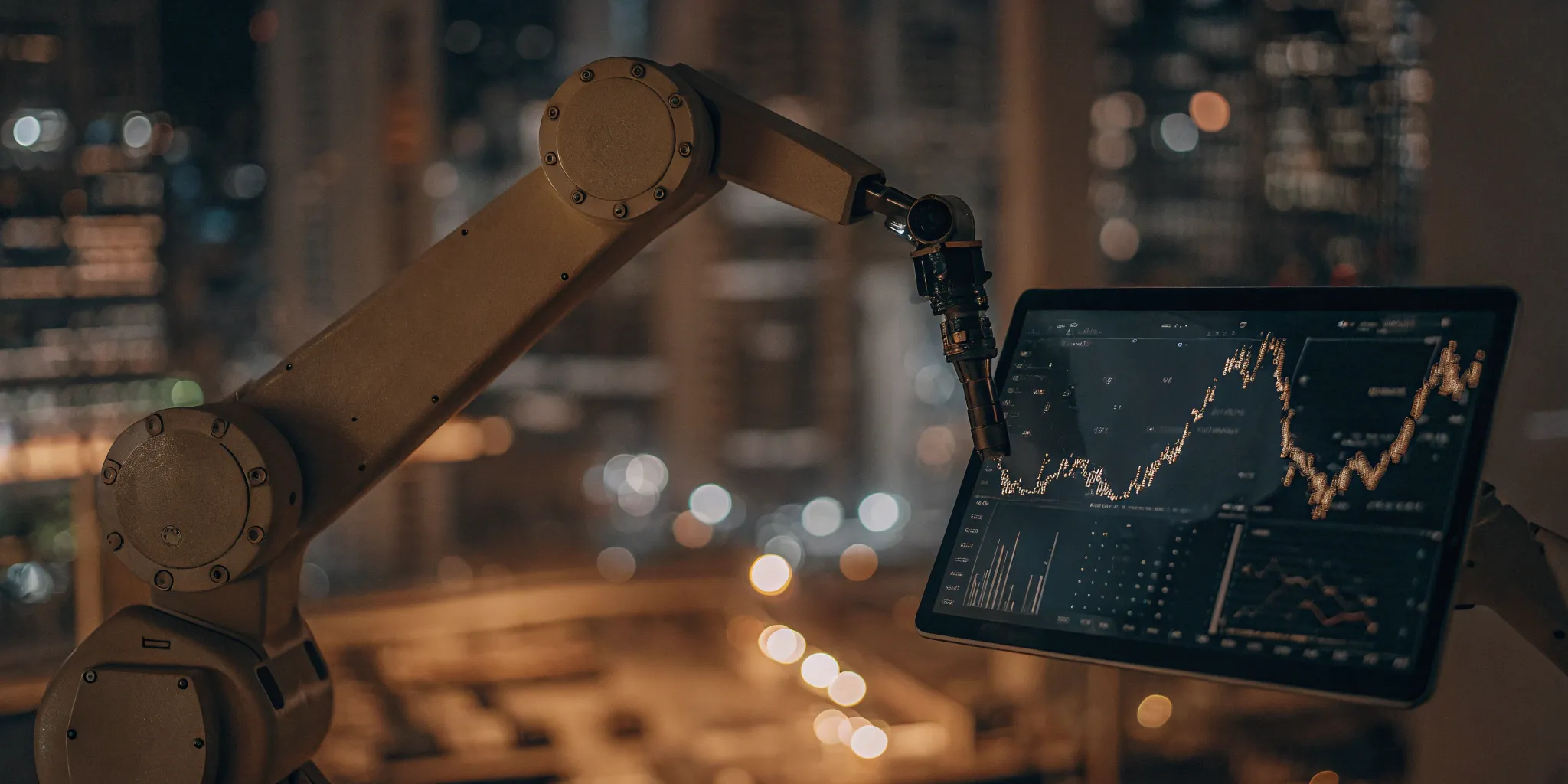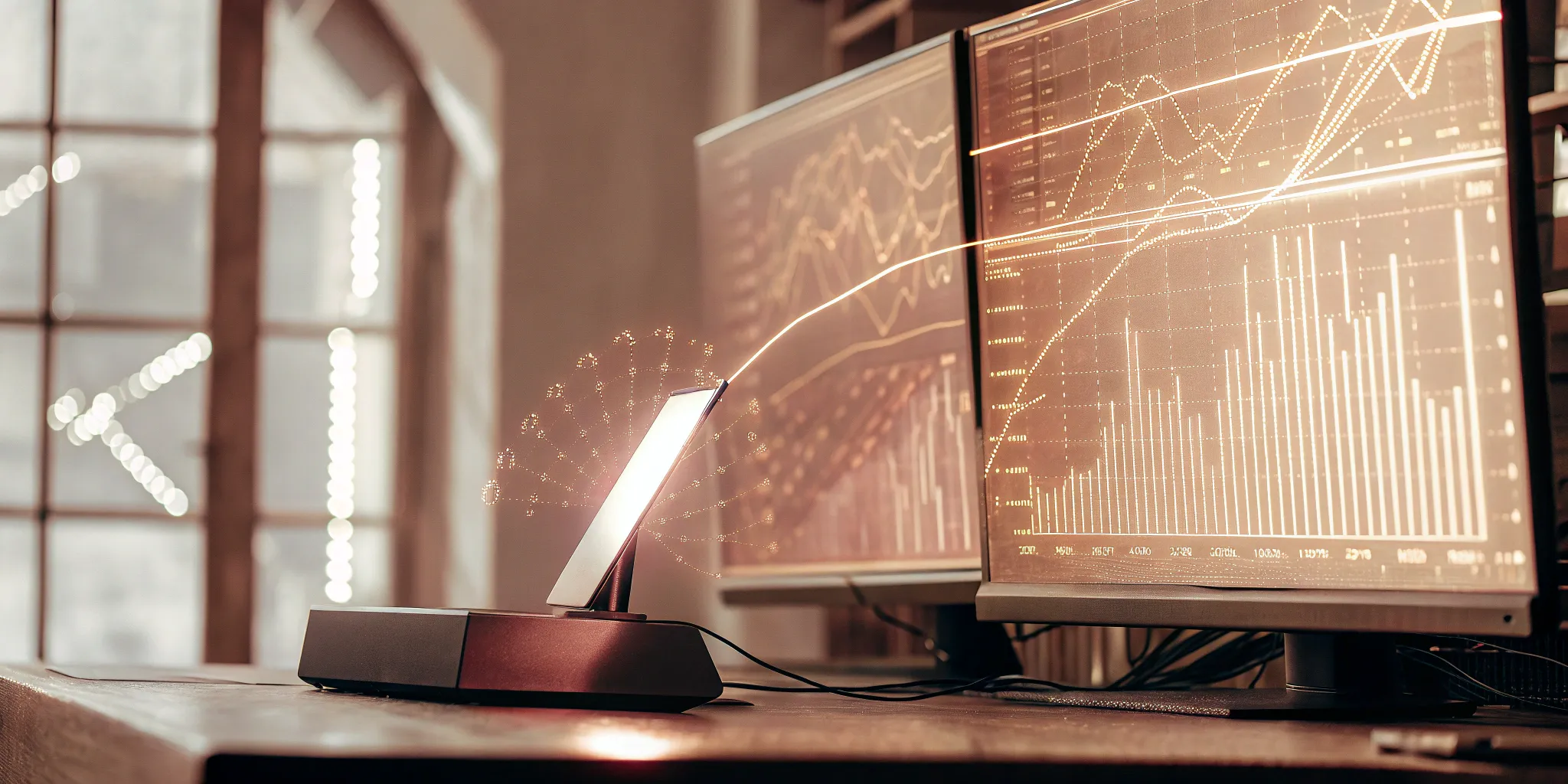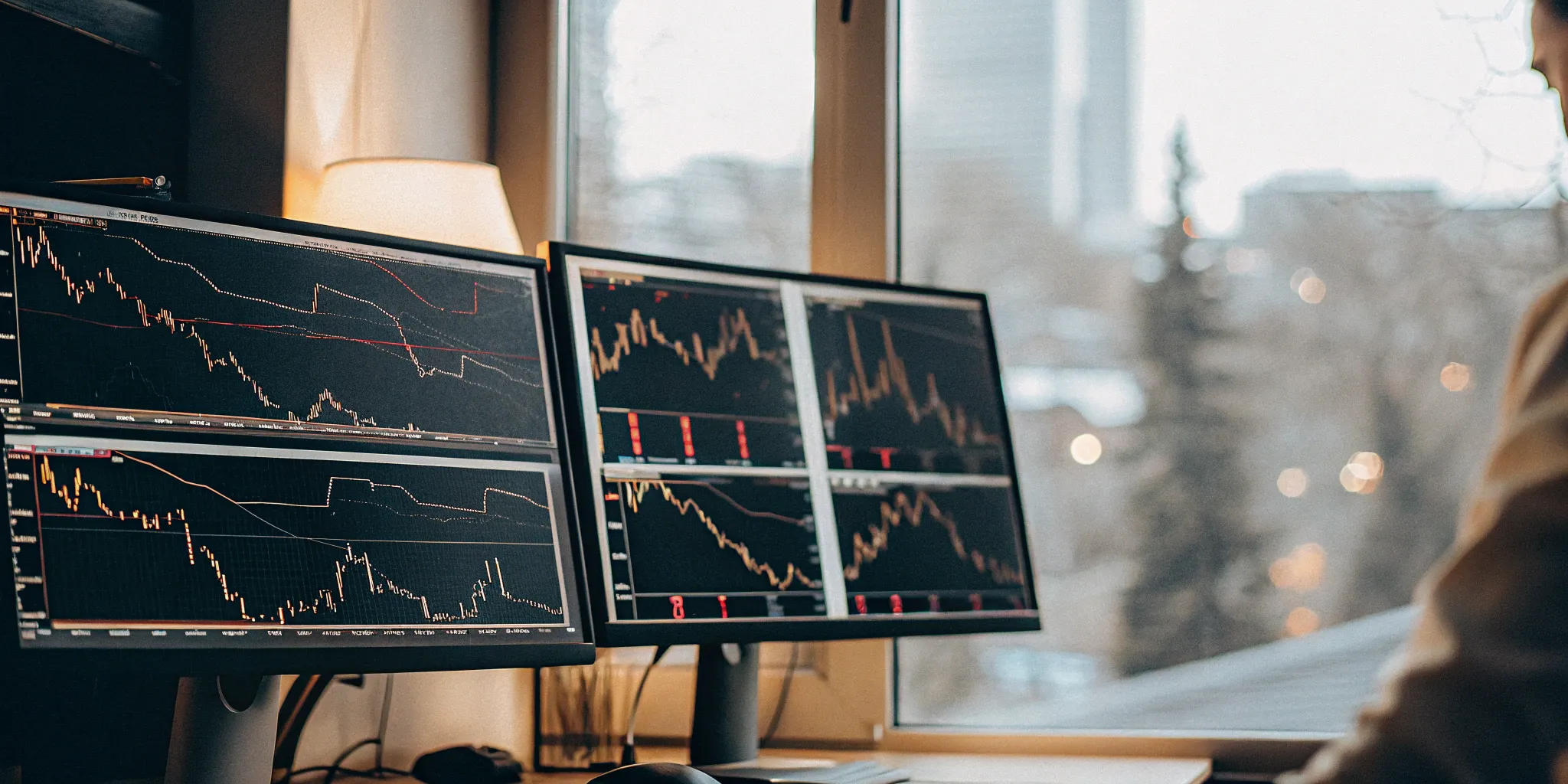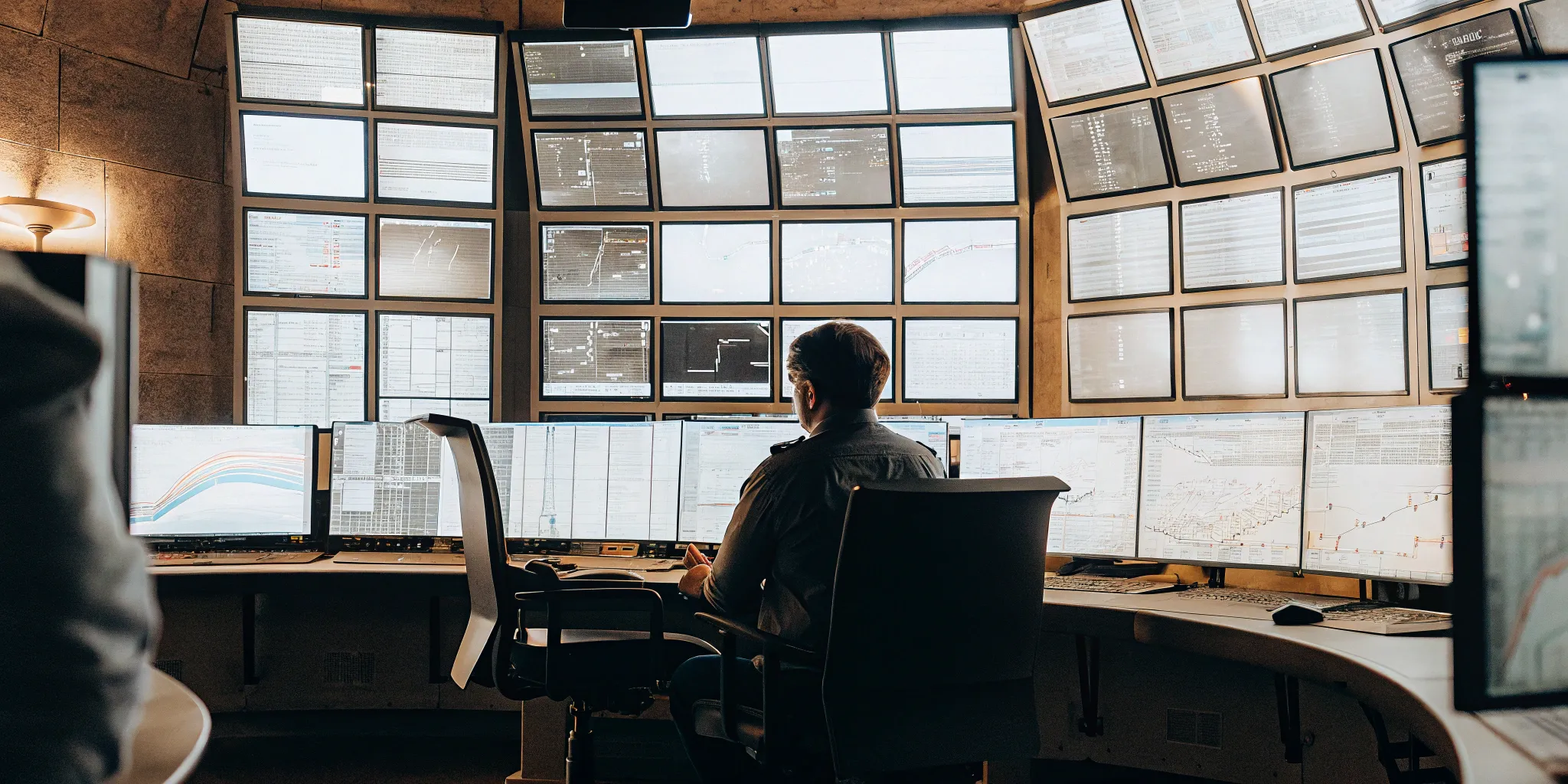For decades, the most powerful trading technologies were kept behind the locked doors of Wall Street firms and hedge funds. High-frequency trading and complex algorithmic analysis were tools for the financial elite, giving them a massive edge. Today, that has changed. The development of sophisticated and accessible AI trading tools has leveled the playing field, allowing individual investors to harness the same kind of data-driven power. This isn’t about just automating a simple strategy; it’s about deploying an intelligent system that can analyze markets, manage risk, and execute trades with institutional-grade precision. This article will explain how you can leverage this technology for your own financial goals.
Principales conclusiones
- Let AI Handle the Heavy Lifting: A quality AI tool removes the biggest obstacle to consistent trading—human emotion. It makes logical, data-backed decisions around the clock, freeing you from the stress of constant market analysis.
- Demand Proof of Performance: Don’t settle for empty promises. A trustworthy AI trading tool will always have a long-term, publicly verified track record, proving its results are consistent and transparent.
- Stay in the Captain’s Chair: Automation doesn’t mean giving up control. The best way to use an AI tool is to monitor its performance and ensure it aligns with your financial goals, combining its analytical power with your personal oversight.
What Is an AI Trading Tool, Really?
Let’s cut through the noise. At its core, an AI trading tool is a sophisticated software program that uses artificial intelligence to make and execute trading decisions on your behalf. Think of it as an expert analyst and a lightning-fast trader rolled into one, working around the clock without ever getting tired or emotional. Some tools are designed to simply automate a strategy you’ve already created, acting as a loyal assistant. Others, like our FAST AI, are far more advanced. They use complex algorithms to analyze market data, identify potential opportunities, and execute trades entirely on their own.
The real difference between a simple script and a true AI trading tool is the ability to learn and adapt. Instead of just following a rigid set of “if-then” rules, a genuine AI system processes vast amounts of information to find patterns a human might miss. This allows it to respond to changing market conditions in real time. It’s not about just automating a task; it’s about delegating the complex analysis and decision-making process to an intelligent system built specifically for that purpose. This approach removes the guesswork and emotional bias that so often lead to costly mistakes in manual trading.
What It Does and How It Helps
So, what does an AI tool do day-to-day? Its main job is to process and analyze enormous datasets—from historical price charts to real-time market news—at a speed no human could ever match. By sifting through this information, the AI identifies high-probability trading setups based on the parameters it was designed to follow. For instance, FN Capital’s FAST AI is programmed to focus exclusively on the EUR/USD pair, using its deep understanding of that specific market to find low-risk entry and exit points.
This helps you by taking the heavy lifting of market analysis off your plate. Instead of spending hours staring at charts, you can rely on the tool to spot opportunities and act on them instantly. This not only saves you time but also provides access to a level of big data en la inversión that was once only available to large financial institutions. It’s about making data-driven decisions, free from the emotional pulls of fear or greed, to pursue consistent performance.
A Look Under the Hood: Key Components
While it might seem like a “black box,” a high-quality AI trading tool is built on several key components working together. The first is the data analysis engine, which is the brain of the operation. It’s responsible for consuming and interpreting market data. Next are the predictive algorithms and modelos financieros that use this data to forecast potential market movements and identify trading signals. This is where the “intelligence” really comes into play.
Just as important is the risk management module. At FN Capital, we call ours the Dynamic Algorithmic Risk Tool (DART). This component’s sole purpose is to protect your capital by automatically adjusting trade sizes, setting stop-losses, and ensuring the overall risk exposure stays within acceptable limits. Finally, the execution engine takes the signals from the AI and places the trades with a broker, ensuring speed and precision. Together, these parts create a system designed for disciplined, intelligent, and automated trading.
How Does an AI Trading Tool Actually Work?
So, what’s really happening inside an AI trading tool? It might sound like something out of a sci-fi movie, but the process is actually quite logical. Think of it as a three-step cycle that runs continuously: it analyzes market data to find opportunities, makes a calculated decision without any emotional baggage, and then acts on that decision instantly. This isn’t about predicting the future with a crystal ball; it’s about using powerful technology to make incredibly smart, data-backed choices at a speed no human could ever match. Let’s break down exactly how it all comes together.
Finding Patterns in Market Data
At its core, an AI trading tool is a master analyst. Its first job is to consume and process vast amounts of information—far more than any person could handle. This includes historical price movements, real-time market data, and economic news releases. The AI is trained to sift through all this noise to find recurring patterns and identify conditions that have historically led to profitable trades. It’s a continuous process of learning and adapting. By leveraging big data en la inversión, these systems can spot subtle, low-risk opportunities that are often invisible to the human eye, giving them a distinct analytical edge in the market.
Making Trades Without Human Emotion
Here’s where AI trading really shines: it operates without fear, greed, or hesitation. Once the AI identifies a high-probability pattern, it makes a decision based purely on data and its programmed strategy. There’s no second-guessing or getting nervous about market swings. This objective approach is critical for consistent performance, as it sidesteps the emotional pitfalls that cause many manual traders to make impulsive mistakes. Advanced systems also incorporate dynamic mitigación de riesgos tools that automatically adjust trade sizes and stop-losses based on real-time market volatility, protecting your capital with cold, hard logic instead of gut feelings.
Executing the Trade Instantly
After the AI makes a decision, it acts immediately. The system automatically executes the buy or sell order in a fraction of a second—a speed that’s impossible to replicate manually. In the world of comercio cuantitativo, where prices can change in milliseconds, this speed is a massive advantage. It ensures that the opportunity identified by the AI is captured at the optimal price, without any delays. This automated execution not only improves precision but also allows the system to manage thousands of trades, working for you around the clock without ever needing a break.
Not All AI Is Created Equal: Types of Trading Tools
When you hear the term “AI trading,” it’s easy to picture a single, all-knowing robot making perfect trades. The reality is a bit more nuanced, and frankly, much more interesting. “AI” is a broad label for a variety of tools, each designed to do a different job. Some are simple rule-followers that execute your commands with speed and precision, while others are complex analytical engines that sift through mountains of data to find patterns you’d never see on your own. Understanding these distinctions is the first step toward choosing a tool that actually fits your financial goals and helps you avoid common pitfalls.
Think of it like building a championship team. You wouldn’t rely on just one star player; you need a full roster with different skills. Some AI tools are the executors, others are the strategists, and some are the intelligence gatherers. The most sophisticated systems, like our FAST AI, don’t just stick to one role. They integrate multiple AI functions—like rule-based execution, predictive analysis, and real-time risk management—to create a comprehensive and adaptive trading approach. This synergy is what separates a basic bot from an institutional-grade AI trading solution. By knowing what’s out there, you can make a much more informed decision about where to put your trust and your capital.
Algorithmic Systems: The Rule Followers
At its core, an algorithmic system is a rule-follower. You give it a set of specific instructions, and it executes them without hesitation or emotion. Think of it as a highly disciplined assistant who follows your playbook to the letter. For example, you could set a rule like, “When EUR/USD crosses its 50-day moving average, buy.” The system will monitor the market 24/5 and execute that trade the instant the condition is met. These tools are fantastic for automating a strategy you’ve already developed. They remove the risk of emotional decisions and ensure you never miss an opportunity because you were away from your screen. This is the foundation of comercio cuantitativo, where strategies are built on clear, data-driven rules.
Predictive Models: The Forecasters
This is where AI starts to feel like a glimpse into the future. Predictive models go beyond just following rules; they aim to create them. These systems use machine learning to analyze huge volumes of historical market data, identifying subtle patterns, correlations, and trends that are invisible to the human eye. The goal is to forecast which way the market is likely to move next. Instead of just executing a pre-set strategy, these tools help generate new trading ideas. They can analyze everything from price action and volume to economic indicators, helping you make more strategic and data-backed decisions. This analytical power is what allows an AI to deliver accurate previsiones de mercado and spot high-probability setups before they become obvious.
News Analysis Tools: The Sentiment Gauges
The market doesn’t just run on numbers; it runs on emotion and information. News analysis tools are designed to read the room. These AI systems scan millions of data points in real-time—from news articles and financial reports to social media posts—to gauge market sentiment. They use natural language processing to determine if the overall feeling about an asset is positive, negative, or neutral. A sudden wave of positive news from the European Central Bank could be a strong buy signal for the Euro, and an AI can spot and act on that trend in milliseconds. By turning unstructured text into actionable data, these tools give you an edge in a market that reacts instantly to new information. This is a perfect example of how leveraging big data en la inversión can lead to smarter, faster trades.
The Pros and Cons of AI-Powered Trading
AI trading tools can feel like a game-changer, and in many ways, they are. But like any powerful tool, it’s smart to understand both what it does well and where you need to be careful. It’s not about finding a magic button that prints money; it’s about using technology to make more strategic, data-backed decisions. Let’s walk through the good and the things to watch out for.
The Upside: Speed, Efficiency, and No Emotional Decisions
The biggest advantage of AI trading is that it removes human emotion from the equation. We’ve all been there—feeling the pressure to sell during a dip or getting a little too excited during a market rally. An AI tool doesn’t feel fear or greed. It operates purely on the logic and data it’s given, executing trades based on complex analysis of market conditions.
These systems work 24/7, analyzing vast amounts of data far faster than any person could. This allows them to spot and act on opportunities in milliseconds. For most people, this means you can implement a sophisticated, hands-free strategy that works for you even while you’re sleeping. It’s a way for inversores minoristas to access a level of trading efficiency that was once only available to large financial institutions.
The Reality Check: Potential Risks and Limitations
Now for the reality check. The internet is filled with bots promising unbelievable returns, and frankly, most are scams. A common issue is survivorship bias, where you only hear about the winning strategies because the failures quietly disappear. This creates a skewed picture of what’s actually possible. That’s why transparency is non-negotiable. You should always look for a long-term, historial verificado públicamente to prove a system’s performance is real and consistent.
Even the best AI needs a solid framework for risk management. An algorithm left completely unchecked could expose you to unnecessary losses during unexpected market events. This is why a system should include built-in risk controls and allow you to monitor performance, ensuring the AI operates within boundaries you’re comfortable with.
How to Choose the Right AI Trading Tool for You
The world of AI trading is exciting, but it’s also crowded. With so many tools promising incredible results, how do you find the one that’s actually right for you? It’s not about finding the “best” tool in the abstract; it’s about finding the best tool for your specific financial situation and goals. Think of it like hiring a specialist for a job. You wouldn’t hire a plumber to fix your car. Similarly, the right AI trading tool should be perfectly suited to the task you give it, whether that’s generating steady passive income or pursuing more ambitious growth.
To make a confident choice, you need to look past the flashy marketing and focus on three core areas: your personal goals, the platform’s security and integrity, and the key features that prove its worth. Breaking it down this way turns a potentially overwhelming decision into a clear, manageable process. It helps you cut through the noise and select a partner for your financial journey that you can truly trust to work on your behalf. Let’s walk through what to look for in each of these areas.
Start With Your Goals and Risk Comfort Level
Before you even look at a single feature, take a moment for a gut check. What are you trying to achieve? Are you looking for a tool to generate consistent monthly returns as a form of passive income, or are you aiming for long-term capital growth? Your answer will guide your search. Some AI systems are designed for high-frequency, low-margin trades that add up over time, while others might take on more risk for potentially higher rewards. Be honest with yourself about your risk tolerance. A good starting point is to review a tool’s historical performance, paying close attention to its average returns and maximum drawdown. This kind of análisis de inversiones will tell you a lot about the journey you can expect.
Vet the Tool’s Security, Compliance, and Support
You’re trusting an algorithm with your hard-earned money, so this step is non-negotiable. A trustworthy AI trading platform should be transparent about its operational structure and security measures. Look for tools that partner with regulated brokers and are clear about how they handle your funds. Some of the most secure platforms use third-party administrators to create a separation between your capital and the technology provider, adding a crucial layer of protection. Beyond the technicals, consider the human element. Is there a support team you can reach out to? A solid platform invests in both its technology and its client support, ensuring its approach to mitigación de riesgos covers all the bases.
Key Features You Shouldn’t Ignore
Great features are about transparency and confidence. First, look for a verified track record. Any platform can claim impressive results, but can they prove it with data from a neutral third party? A publicly verified performance history shows a commitment to transparency that speaks volumes. Second, see if there’s a way to test the tool without taking a huge financial leap. A money-back guarantee is a great sign that a company stands behind its product. Finally, while AI offers hands-free trading, you should never be in the dark. The platform should provide a clear, real-time dashboard so you can monitor performance and stay informed about your investment’s progress.
A Quick Look at Popular AI Trading Tools
The world of AI trading is buzzing with tools designed to give you an edge. From automated bots that trade crypto 24/7 to sophisticated analysis platforms that spot trends, there’s a solution for almost every style of investor. But with so many options, it’s easy to feel overwhelmed. The key is to understand what these tools actually do and which ones align with your personal trading goals. Some are built for hands-on technical analysts who love digging into charts, while others are designed for traders who want to automate a specific strategy. Think of this as a quick tour of the neighborhood to get a feel for what’s out there. We’ll look at some of the popular names in the space and break down what you can generally expect in terms of features and costs. This will help you see the landscape more clearly and decide what kind of approach makes the most sense for you.
An Overview of the Top Contenders
When you start exploring, you’ll notice a few names pop up frequently. TradingView, for instance, is incredibly popular, but it’s primarily known for its powerful charting tools and social networking features for traders; its automation capabilities often require connecting another service. Then you have platforms like Cryptohopper, which lets you automate trading strategies across multiple crypto exchanges. For those who live and breathe technical analysis, TrendSpider uses AI to automatically detect chart patterns and trendlines, saving you hours of manual work. Each tool serves a different purpose—some help you find opportunities, while others execute trades for you. The common thread is that they require you to bring your own strategy to the table.
Comparing Their Features and Costs
The biggest draw of these tools is their ability to trade around the clock without emotion, executing your strategy based on pure data. However, it’s important to remember they are not crystal balls; they can’t predict sudden market shocks and can be vulnerable to technical glitches. Most of these platforms operate on a monthly subscription model. For example, a basic plan on TradingView might start around $15 per month, while a more specialized tool like TrendSpider can run upwards of $30 per month. The right choice depends entirely on how hands-on you want to be. Are you looking for a tool to enhance your own analysis, or do you want a system that manages the entire process for you?
How to Use AI Trading Tools Responsibly
AI trading tools are incredibly powerful, but they aren’t magic wands. Think of them as a highly skilled co-pilot for your investment journey—they handle the complex calculations and rapid-fire execution, but you’re still the captain of the ship. Using these tools responsibly means staying engaged and informed, creating a partnership with the technology where you understand its role and your own. This approach not only protects your capital but also helps you make smarter decisions over the long term.
The goal isn’t to hand over control blindly; it’s to leverage a system that operates without emotional bias and at a speed no human can match. Responsible use starts with choosing a platform that prioritizes transparency and robust mitigación de riesgos. At FN Capital, our DART (Dynamic Algorithmic Risk Tool) is designed for this very purpose, continuously optimizing positions and exposure in real time. However, even the most advanced systems benefit from human oversight. By setting clear boundaries, regularly checking in on performance, and ensuring everything operates within legal guidelines, you can harness the full potential of AI without taking on unnecessary risks. It’s this blend of automated intelligence and human oversight that truly defines successful AI-powered investing.
Keep a Human Eye on Your AI
While the beauty of AI trading is its automation, it doesn’t mean you should set it and forget it entirely. The AI handles the heavy lifting—analyzing vast amounts of data and executing trades based on its findings—but your oversight is what keeps the strategy aligned with your goals. Think of it as a regular check-in. You’re there to ensure the system is operating as expected and to make informed choices if market conditions change dramatically. This human-in-the-loop approach prevents excessive losses and ensures the AI’s automated decisions remain grounded and sensible, giving you peace of mind while the system works for you.
Monitor Performance and Refine Your Strategy
Consistently reviewing your AI tool’s performance is fundamental to long-term success. This goes beyond just looking at your account balance. A trustworthy platform will provide clear, detailed metrics on its trading activity. For example, FN Capital offers a fully transparent, Historial verificado de 4 años on FX Blue, so you can see everything from the win rate to the risk-to-reward ratio. Regularly reviewing this data helps you understand the AI’s behavior, confirm it’s performing as promised, and build confidence in your strategy. It’s your way of holding the technology accountable and ensuring it continues to meet your investment objectives.
Understand the Rules and Stay Compliant
The financial markets are built on a foundation of rules and regulations designed to protect everyone involved. Using an AI trading tool that operates outside of these guidelines is a risk you can’t afford to take. Reputable providers will be transparent about their compliance and legal structure. For instance, FN Capital uses a Third Party Fund Administrator (TPFA) model to provide clients with a compliant gateway to asset management solutions. This ensures that everything is above board. Before committing to any tool, make sure you understand how it adheres to financial regulations. This protects your investment and ensures you’re working with a partner committed to operating ethically and legally.
Artículos relacionados
- Cómo funciona AI Trading: Estrategias y ventajas
- AI Algo Trading Explained: A Beginner’s Guide
- AI Options Trading: A Smart Guide
- Las 8 mejores plataformas de trading con IA: Encuentre su combinación perfecta
Preguntas frecuentes

Do I need to be a trading expert to use this? Not at all. The entire system was designed so you don’t have to be a market analyst to participate. The AI handles the complex work of analyzing market data, identifying opportunities, and executing trades. Your role is to get set up and then monitor the performance. It’s built for anyone who wants to use a data-driven approach to their investments without the steep learning curve of manual trading.
How is this different from other trading bots I see online? That’s a great question, because the difference is significant. Many online bots are simple programs that just follow rigid “if-then” rules and often lack a proven history. Our FAST AI is a far more sophisticated system that uses deep analysis and adaptive risk management. Instead of chasing dozens of markets, it focuses exclusively on the EUR/USD pair for maximum efficiency. The biggest distinction is our commitment to transparency—we have a four-year, publicly verified track record that shows our real-world performance over time.
How do I know my investment is secure? Your security is the top priority, and the system is structured to protect your capital. We work with regulated international brokers and use a Third Party Fund Administrator (TPFA). Think of the TPFA as a secure intermediary. Your funds are held with them, which creates a clear separation between your money and our technology. This structure provides a crucial layer of security and compliance that you won’t find with most retail trading tools.
Is this a “set it and forget it” system? While the AI is fully autonomous and designed to be hands-free, we believe responsible investing means staying informed. The system does all the trading for you 24/5, but you are always in the loop. You’ll have access to a dashboard where you can monitor your account’s performance in real time. It’s less about “forgetting” your investment and more about having the confidence to let a proven system work for you while you live your life.
What does a “verified track record” actually mean? It means our performance history isn’t just something we claim—it’s confirmed by an independent, third-party service called FX Blue. This service connects directly to the trading account and records every single trade, providing an unbiased and transparent report of our results over the past four years. It’s your proof that the strategy has performed consistently through various market conditions, not just during a recent hot streak.





